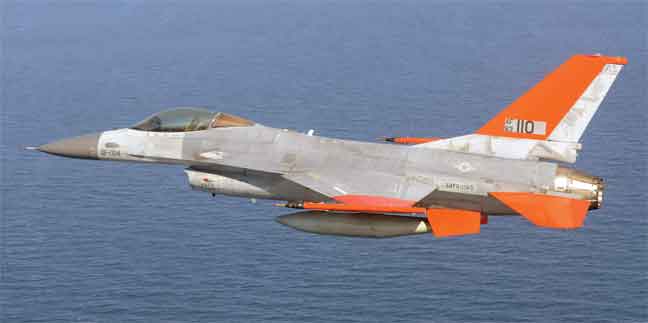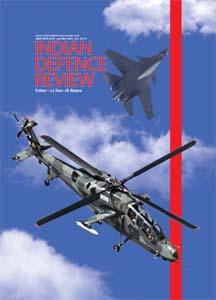
The fighter-bomber will continue to remain the main instrument for prosecuting air war. Their main characteristics would be agility, super cruise, stealth, multi-function Active Electronically Scanned Array (AESA) radars, network-centric systems, integrated glass cockpits, fibre-optics data-transmission, multi-spectral sensors, fused situational picture, helmet mounted sights, and Precision Guided Weapons (PGM). Fighters will continue to strive to have ‘First-look, first-shoot, first-kill’ ability. The one, who controls the space, will control the air in future. Aerospace craft will aim to seize control, establishing dominance/supremacy over the enemy’s aerospace assets. They will operate under the control/co-ordination of space-based Early Warning and Control satellites with increased Artificial Intelligence (AI).
The aerial systems of 2040 and beyond are shaping up in defence research laboratories around the world, but more actively in the United States (US). The US Air Force (USAF) and US Navy (USN) are leading the evolution of new technologies and platforms. Defense Advanced Research Projects Agency (DARPA), US Air Force Research Labs (AFRL), Boeing ‘Phantom Works’, Lockheed Martin’s ‘Skunk Works’ and NASA are looking at concepts of future ‘Air Dominance’.
The world already has eight overt nuclear powers, one covert nuclear power (Israel), and at least two nuclear aspirants (Saudi Arabia and Iran)…
The Americans, Chinese and Russians are also working on the Sixth-Generation fighters which will be inducted from 2030 onwards. From the emerging designs, it is clear that the fighter bomber as a platform is still here to stay. More and more of these will become uninhabited or optionally manned. There will be significant changes in the aerial platform performance, reach and accuracy of aerial weapons. More and more aerial platforms will transit through upper stratosphere bordering space and fly at hypersonic speeds. Aerospace will soon become a single domain. Combat engagements will be at much higher speeds and much greater distances.
Aerospace Dominance
The fighter-bomber will continue to remain the main instrument for prosecuting air war. Their main characteristics would be agility, super cruise, stealth, multi-function Active Electronically Scanned Array (AESA) radars, network-centric systems, integrated glass cockpits, fibre-optics data-transmission, multi-spectral sensors, fused situational picture, helmet mounted sights and Precision Guided Weapons (PGM). Fighters will continue to strive to have ‘First-look, first-shoot, first-kill’ ability. The one, who controls the space, will control the air in future. Aerospace craft will aim to seize control, establishing dominance/supremacy over the enemy’s aerospace assets. They will operate under the control/co-ordination of space-based Early Warning and Control satellites with increased Artificial Intelligence (AI).
Satellite/aircraft based kinetic and Directed Energy Weapons (DEW) will soon be a reality and will be used for aerial or surface attack. Similarly, attacking electronics of aerospace craft using high fidelity lasers or other forms of directed energy, will be the norm. Even if aerospace supremacy cannot be fully established, the capability to use technology asymmetry to achieve a ‘degree of dominance’ in the air-space bubble in a given area and given time-domain to prevent prohibitive interference by opposing air forces will be desired.
The USAF is leading the way ahead for a ‘Next Generation Tactical Aircraft’…
Changing Air Threats
The world already has eight overt nuclear powers, one covert nuclear power (Israel) and at least two nuclear aspirants (Saudi Arabia and Iran). The Nuclear Non-Proliferation Treaty (NPT) is still not fully effective. More and more countries are acquiring missile technology and even Tactical Nuclear Weapons (TNW). The weapons delivering air platforms are becoming faster and more efficient for deeper penetration. Both surface and aerial missiles are becoming faster, more accurate, have longer range and larger multiple warheads. Space-based assets will start having DEWs. With more and more offensive and defensive means on space-based platforms, they will also be targets. Weaponisation of space will be a logical next step.
AI will take over more aerial functions, thus making unmanned systems more intelligent and autonomous. More accurate ground-based air defence systems will be required to take on small-sized projectiles coming at very low level at high speeds from short distances. The non-state actors and rogue regimes which follow no international norms and ethics, are trying to acquire weapons of mass destruction. They could be a difficult-to-define threat. Any future air platforms would have to factor in all this.
Uninhabited Aerial Systems
Uninhabited aircraft technologies are already proven and the future is Uninhabited Aerial Systems (UAS). The world is in transition. There are some who see the F-35 JSF as the last dedicated manned fighter/bomber. Solar-powered UAS are already flying. Currently, the solar-powered Zephyr holds the endurance record for UAS, with 14 days in the air. Dual use (optionally manned) aircraft are also flying. The USAF has already modified F-4s and F-16s to fly them remotely. In France, Dassault leads a multi-nation delta wing UCAV ‘Neuron’ of the size of Mirage 2000. The UK has a Strategic UAS program ‘Taranis’.
UAS such as the Northrop Grumman X-47B are taking-off and landing by themselves including on moving aircraft carrier. Autonomous mid-air refuelling has been tested. Lockheed Martin’s UCLASS drone ‘Sea Ghost’ looks rather like a stealth bomber and is expected to carry 1,000-pound class weapons. The US is also working on Hypersonic (Mach 6) Bomber which is likely to be optionally manned. Uninhabited helicopter convoys will deliver supplies to troops deployed on combat front lines.
A swarm of cheap Uninhabited Air Systems (UAS) could saturate defences. The US Army’s dramatic shift to a nearly all-unmanned flight over the next three decades is embedded in the UAS roadmap. The USAF’s UAS vision document indicates that by the year 2047 every mission would be unmanned.
The non-state actors and rogue regimes which follow no international norms and ethics are trying to acquire weapons of mass destruction…
USA’s Next Generation Combat Aircraft
The USAF is leading the way for a ‘Next Generation Tactical Aircraft’. This is meant to see them through till 2050. It will initially augment and later replace the F-35 and F-22 combine. This ‘Sixth Generation Fighter’ would have enhanced capabilities in reach, persistence, survivability, net-centricity, sustained awareness, human-system integration and weapon effects. Boeing’s proposal is currently limited to concept images and the USAF still remains unsure and non-committal. Boeing envisages the F/A-XX, F-X and a possible Unmanned Combat Air Vehicle (UCAV) comprising an all-encompassing future strategy for the USAF. Boeing is also responding to the US Navy’s Request For Information regarding a new aircraft that could replace its fleet of new and larger variant of the Super Hornet by around 2030. The regular Hornet aircraft is already planned to be replaced by the F-35s. Lockheed Martin’s proposal calls for greater speed, range, stealth and self-healing structures; developments that will require new breakthroughs in propulsion, materials, power generation and weapon technology.
Self-healing structures in particular, would offer significant advantage over modern-day aircraft, remaining airborne despite taking heavy fire. The system comprises pockets of epoxy resin and a hardener, installed around vulnerable parts of the aircraft such as the underbelly, hatchways and wheel wells. If the area is damaged, the contents of the pocket are released to form a temporary plug, helping the aircraft to operate in spite of the damage. New generation engines will allow ultra-high-altitude super-cruise. The avionics are supposed to withstand next generation electronic-attack and cyber-attack, have passive detection, and integrated self-protection. The tailless flying wing, ‘cranked kite’ design concept currently appears the way forward for future fighter aircraft. The sixth-generation fighters are expected to use advanced engines with ‘Adaptive Versatile Engine’ technology to allow longer ranges and higher performance, where the ratios of airflow bypass and compression can be made variable to improve efficiency.
Future Aerial Weapons
Future aerial missiles would utilise scramjets for higher speed. Despite failing its recent tests, Boeing’s X-51A Waverider scramjet remains in development as it hopes to reach hypersonic speeds approaching Mach 6, a speed at which a missile cannot be intercepted by conventional air defence technology. Continued experiments with DEW and lasers, for defensive as well as offensive measures, to deliver effects at the speed of light, will shape future combat. New aircraft will be as much about reusable weaponry such as lasers, as it is about expendable weaponry. Three categories of lasers – low-power for illuminating, tracking, targeting and defeating enemy sensors; moderate-power for protection to destroy incoming missiles and high-power to offensively engage enemy aircraft and ground targets, will be required.
A survivable, long-range missile with combined air-to-air and air-to-ground capabilities is being evolved…
The USAF is developing a new air-to-air missile dubbed the Small Advanced Capabilities Missile (SACM) for the 2030s. SACM would have an improved solid rocket motor having synergised control enabled by aero attitude control and thrust vectoring. The missile will have improved ‘high-off-bore-sight’ capability for rear hemisphere kills and ‘lower-cost-per-kill’. The missile would also incorporate energy optimising guidance, navigation and control. The Miniature Self-Defense Munitions (MSDM), will enhance future platforms self-defense capability, without impacting the primary weapon payload. A sixth-generation missile could replace AMRAAM.
A survivable, long-range missile with combined air-to-air and air-to-ground capabilities is being evolved. Range would be a big factor to counter potential adversaries with Chinese PL-15 (200 km). It will be multi-band, broad spectrum – which aids it in survivability en route to the target. DARPA’s Triple Target Terminator (T3) programme envisions combined capabilities of Raytheon’s AIM-120 and AGM-88 High-speed Anti-Radiation Missile (HARM). No aircraft is invisible and using stand-off weaponry early in an air campaign to open up weaknesses in an enemy’s air defence will be required even for fifth-generation fighter aircraft to operate in the area without incurring excessive risks.
Development of solid-state airborne laser capability is already underway. The solid-state laser systems defensively create a sanitised sphere of safety around the aircraft, shooting down or critically damaging incoming missiles and also the approaching aircraft with laser turrets. They will also be used for attacking targets on the ground, such as high value individual terrorists/militants with pinpoint precision or shooting down ballistic missiles and other traditional targets.
Controlling aircraft’s heat signature while using laser weaponry will be an issue. Developing thermal accumulators or off-board venting to manage the heat is being attempted. Newer liquid based lasers promise enough energy (about 150kW) sufficient to bring down an aircraft yet be small enough to be mounted on a jet fighter. More efficient power sources will be required onboard for additional electrical power requirement for high powered lasers.
New Aerospace Technologies
Technologies are offering enhanced capabilities that are driving operational employment and tactics. Smart structures with Artificial Intelligence (AI) and hybrid systems will dictate the future. Demand for streaming high-quality data requires bandwidth which involves innovating sensor/processing systems. Mission computer systems and network-centric payload processing units enable onboard data fusion prior to sending to digital links. Thermally efficient, high-performance computing onboard the aircraft is essential. Next-generation avionics would be smaller, more efficient and capable of operating under extreme conditions. Gallium Nitride (GaN) is a semiconductor material that is more efficient, easier to cool and improves reliability for radars. A system must be designed with the aim of maintaining a competitive advantage in an austere budget environment.

Click to buy subscription
The Passive Aero-elastic Tailored (PAT), a uniquely designed composite wing will be lighter, more structurally efficient and have flexibility compared to conventional wings. This wing will maximise structural efficiency, reduce weight and conserve fuel. Hypersonic cruise, fuel cell technologies, hybrid sensors, improved human-machine interface using data analytics and bio-mimicry, combination of materials, apertures and radio frequencies that ensure survival in enemy territory are under development. Things will be built faster, better and more affordably, using 3D-printing yet ensuring quality and safety standards. Additive 3D manufacture creates a world with spare parts on demand, faster maintenance and repairs, more effective electronics and customised weapons.




